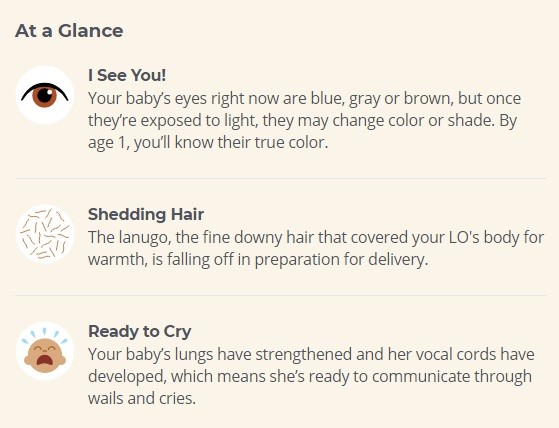
At the 38th week of pregnancy, the thoughts of a woman are occupied by the forthcoming birth. From day to day, the baby can be born, it is quite difficult to predict the expected date of birth precisely. A child born at this period is considered full-term and is able to quickly adapt to new conditions of life outside the womb.


Fetal development
At 38 obstetric week, the baby is not so rapidly gaining weight. The placenta is aging, its blood supply is deteriorating, and nutrients are getting less and less every day. The weight of the fetus at this period is 3000-3500 g, height – 50-53 cm. In the future, the baby will gain no more than 200 g per week.
All organs and systems of the fetus are fully formed. Only the small (pulmonary) circulation does not function. Small circle starts only with the first inhalation of the newborn. So far the heart pumps blood only through a large circle of blood circulation at a speed of 120-160 beats per minute.
The skin of the fetus at week 38 is pale pink, partly covered with original lubricant and gun hair. Auricle cartilage is dense, fatty tissue is well developed. The navel is in the middle between the pubis and the sternum. All these signs are found only in full-term newborns and indicate that intrauterine development is fully completed.
In the last weeks of gestation, the adrenal glands of the fetus begin enhanced cortisol synthesis. The peak of this hormone falls on the very beginning of labor. Synthesizing cortisol, the baby determines the date of its birth. Influencing this process without the use of special medicines is quite difficult.
Condition of a woman
At the 38th week of pregnancy, the expectant mother notices specific signs – the harbingers of the upcoming birth:
- lowering of the abdomen;
- cervical dilatation;
- weight loss;
- diarrhea;
- exit mucus plug;
- the appearance of training fights.
In the last weeks of pregnancy, the baby moves to the entrance to the pelvis. The uterus descends and is now located midway between the navel and the sternum. Pressure on internal organs decreases, heartburn decreases, it becomes easier to breathe. At the same time, urge to urinate due to the pronounced pressure of the uterus on the bladder.
Late stools – another precursor of imminent labor. The intestine of the future mother is cleared of ballast substances before an important event. Diarrhea persists for several days, not accompanied by abdominal pain or nausea. A weight reduction of 2-3 kg is possible.
Discharge at week 38 is enhanced by the discharge of mucus plug. The yellowish-white structure covering the entrance to the uterus is excreted in parts or in its entirety. Perhaps the appearance of light pulling pain in the lower abdomen.
Training fights disturb mainly at night. Unlike real contractions, they do not last long, go irregularly and do not lead to a change in the cervix. At any time, false contractions can turn into true contractions and lead to the development of regular labor.
Harbingers of childbirth in nulliparous women occur 2-4 weeks before the baby is born. With repeated birth, significant signs appear later, a few days before the birth of the child. The severity of symptoms is individual and depends on the overall sensitivity of the woman and the characteristics of the hormonal background.
The movements of the fetus at week 38 do not feel as good as before. Growing up baby in the uterus closely. Heads or buttocks pressed to the small pelvis do not add maneuverability either. Fetal movements become weaker, but still feel at least 10 times a day. The weakening or strengthening of fetal activity indicates the development of hypoxia. In this situation, it is imperative to see a gynecologist and undergo the necessary examination by a specialist.
Go to another page: